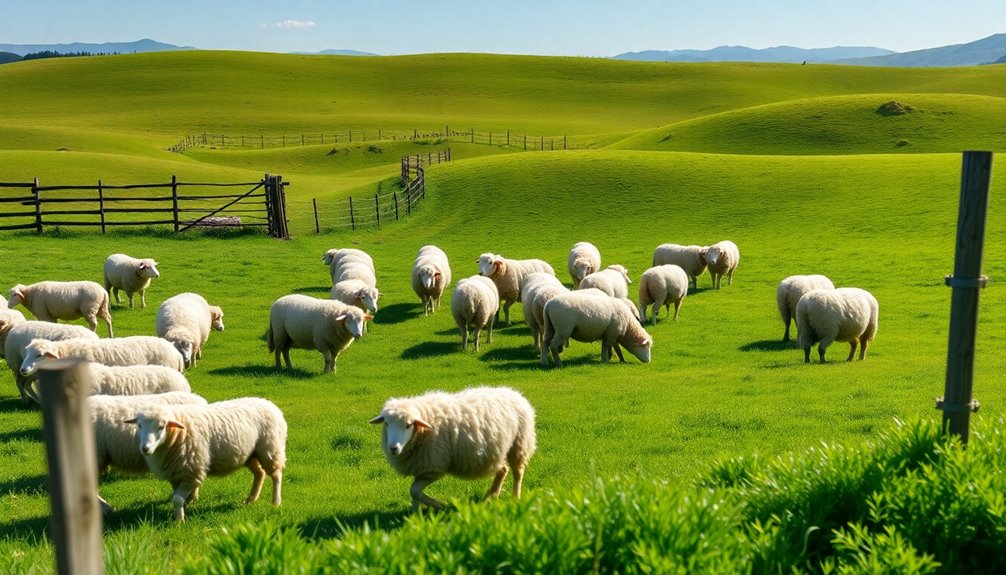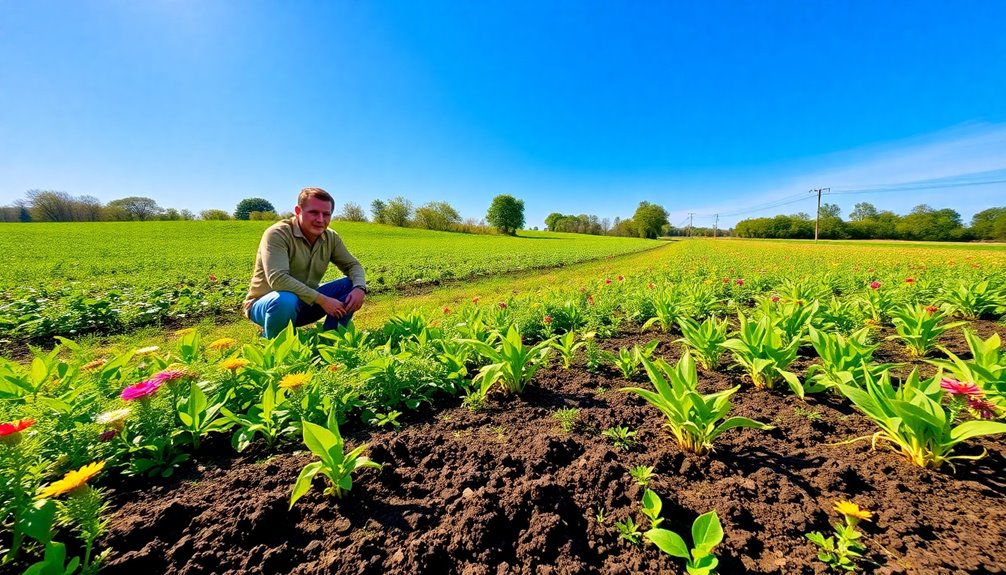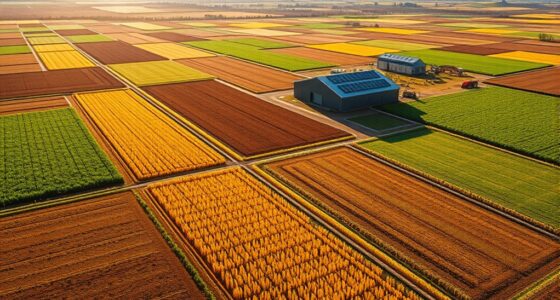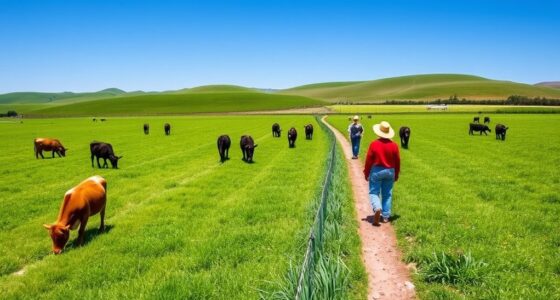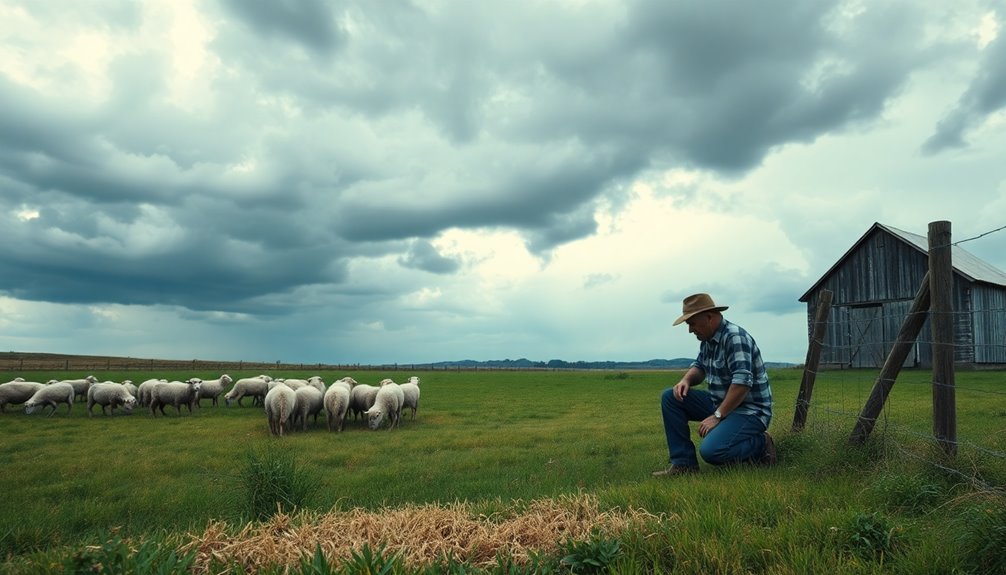To optimize your grazing land for maximum yield, aim for a stocking rate of 8 to 10 ewes and lambs per acre. If you use rotational grazing, you can support around 10 ewes and 15 lambs per acre. Keep in mind that pasture management is essential, so implement strategies like strip grazing and guarantee proper recovery periods for your land. Regularly monitor pasture conditions to adapt your approach and maintain high-quality forage. With the right techniques, you'll boost productivity and sustainability, setting the stage for even more effective management strategies. Explore further to discover best practices for your grazing operation!
Key Takeaways
- For optimal profitability, maintain stocking rates of 8-10 ewes and lambs per acre using effective pasture management strategies.
- Implement rotational grazing, supporting approximately 10 ewes and 15 lambs per acre, to enhance pasture health and yield.
- Allow pasture recovery periods in grazing plans to prevent overgrazing and maintain forage quality over time.
- Regularly assess pasture conditions and utilize a grazing calendar to ensure diverse forage availability throughout the grazing season.
- Incorporate legumes and cover crops to improve soil fertility and support higher stocking rates without compromising pasture quality.
Understanding Stocking Rates
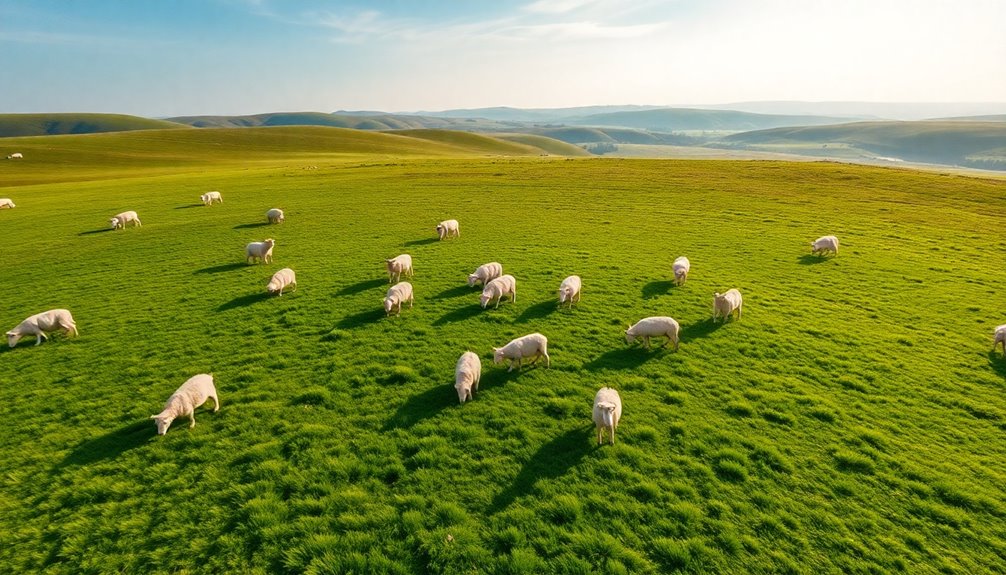
Understanding stocking rates is vital for anyone looking to optimize their sheep farming operation.
In a rotational grazing system, the general stocking rate is about 10 ewes and 15 lambs per acre, while continuous grazing supports only around 2 sheep per acre.
You'll need to take into account environmental conditions, pasture quality, and breed selection, which can greatly affect your stocking rates.
A well-managed grazing plan is essential; it should include pasture recovery periods to maintain healthy forage growth.
If you exceed recommended stocking rates, be prepared to invest in supplemental feeding to keep your herd healthy.
Ultimately, matching stocking rates to pasture productivity is key for maximizing both sheep performance and land yield as part of effective pasture management.
Benefits of Rotational Grazing
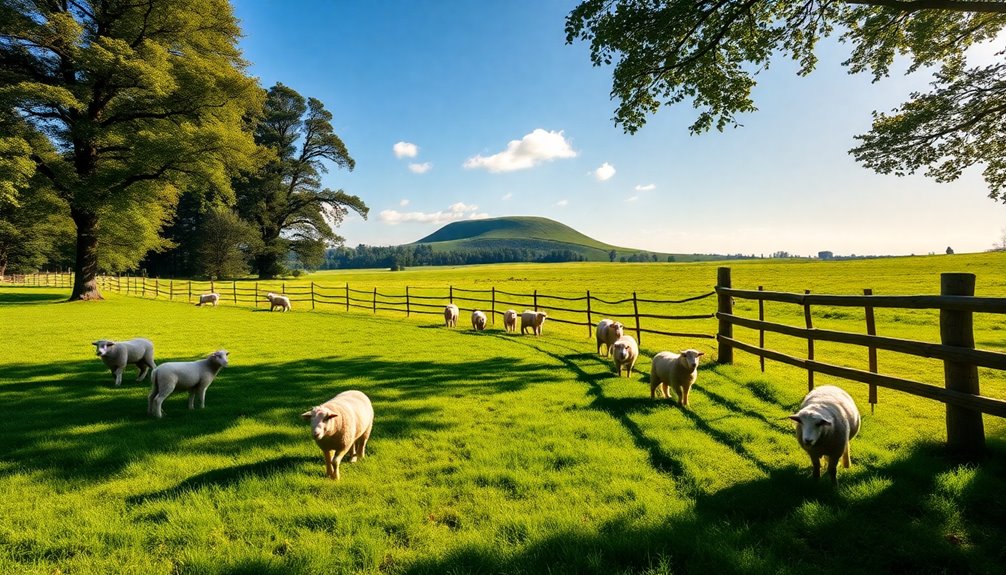
Rotational grazing transforms the way you manage your pasture, offering numerous benefits for both your sheep and the land. By allowing pasture plants to recover, you'll notice increased forage productivity and healthier soil.
This management practice also enhances herd health by reducing the risk of disease and internal parasites, as your sheep won't be grazing the same spot continuously.
Here are some key benefits of rotational grazing:
- Boosts pasture biodiversity, helping to suppress weeds
- Increases stocking rate, allowing about 10 ewes and 15 lambs per acre
- Promotes legumes that fix nitrogen, reducing fertilizer needs
- Enhances overall forage quality for a healthier flock
- Improves resilience of your pasture against drought and erosion
- Additionally, maintaining proper ventilation is crucial for both livestock and pasture health.
Implementing rotational grazing can truly optimize your grazing land!
Dietary Requirements of Sheep
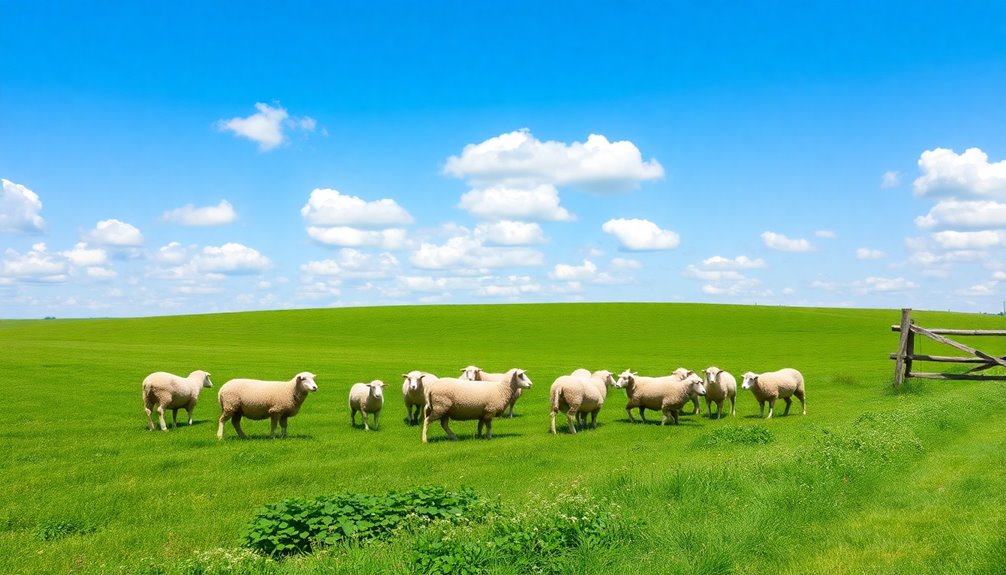
When it comes to keeping your sheep healthy and productive, meeting their dietary requirements is essential. Sheep need daily food intake of 2.5 to 3% of their body weight, primarily from fresh grasses and legumes found in your grazing pasture. While grain can provide supplemental energy, be cautious with amounts to avoid obesity. When pasture is lacking, high-quality hay becomes vital. Proper supplementation with vitamins and minerals during challenging seasons helps maintain health.
| Dietary Component | Importance |
|---|---|
| Fresh Grass | Primary nutrient source |
| Grain | Energy supplement |
| High-Quality Hay | Essential when pasture is low |
| Vitamins & Minerals | Support overall health |
Factors Influencing Grazing Capacity
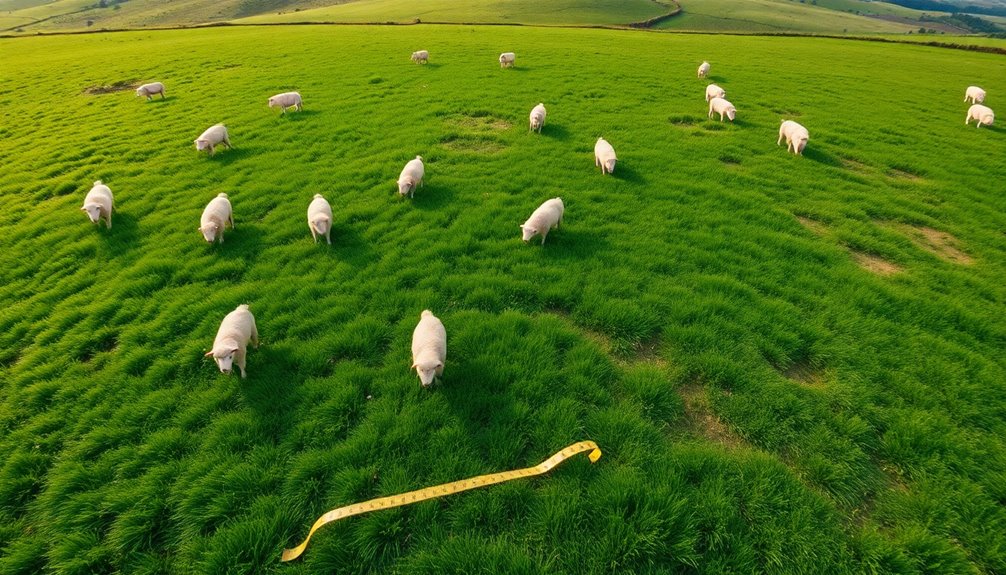
Several factors influence grazing capacity, determining how many sheep you can sustainably support on your land.
Understanding these factors helps you optimize stocking rates and maximize your yield.
- Climate conditions affect forage growth.
- Pasture quality can limit or enhance sheep graze.
- Sheep breed impacts their dietary needs.
- Diverse forage species improve overall grazing capacity.
- Supplemental feeding may be necessary for higher stocking rates.
Pasture and Forage Management
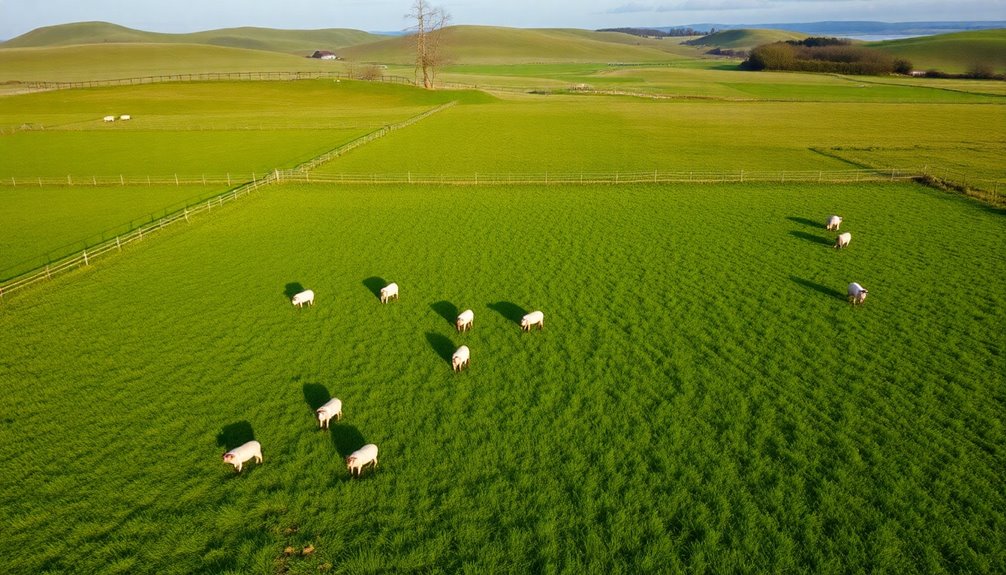
When managing your pasture, it's essential to understand the importance of forage variety and how soil and climate factors impact growth.
Different types of forage, like cool-season grasses and legumes, can boost your sheep's health and productivity.
Forage Variety Importance
Forage variety plays an essential role in ensuring your sheep remain healthy and productive. By incorporating a diverse selection of forages, you can enhance their nutritional intake and improve overall productivity.
Here are some key benefits of enhancing forage variety in your permanent pasture:
- Boosts sheep health with diverse options like Sainfoin, timothy, and orchard grass.
- Improves soil health by including clovers that fix nitrogen.
- Supports high grazing pressure, vital for ideal growth during lamb finishing.
- Implements effective grazing practices like Managed Intensive Grazing (MIG).
- Promotes regrowth and prevents overgrazing, ensuring quality forage availability.
Adopting various forages will keep your grazing system thriving while maximizing yield throughout the grazing season.
Soil and Climate Factors
Understanding soil and climate factors is essential for effective pasture and forage management. Different soil types, like Honeoye, Lansing, and Lima silt loam, influence your choice of forage plants and overall pasture productivity. Climate variations dictate which grasses thrive, especially cool-season grasses in regions like upstate New York.
| Soil Type | Forage Plants | Impact on Productivity |
|---|---|---|
| Honeoye | Clover, Timothy Grass | High |
| Lansing | Orchard Grass | Moderate |
| Lima silt loam | Rye Grass | Moderate |
| Other | Mixed Forages | Variable |
Regularly monitoring soil moisture and plant health helps you adjust grazing practices, ensuring ideal nutrient availability for your sheep. Consider techniques like Managed Intensive Grazing to maintain pasture health.
Common Challenges in Sheep Farming
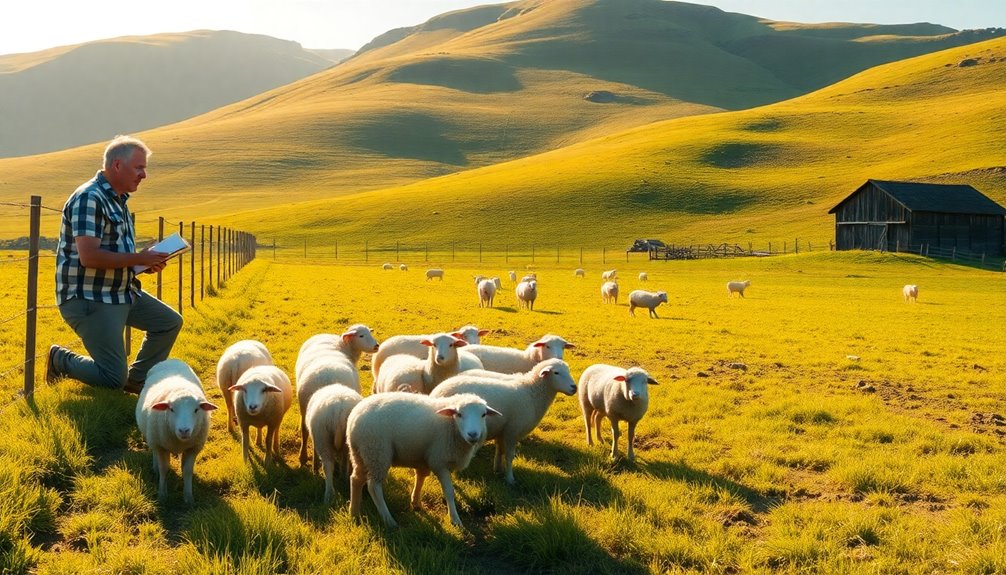
What challenges do sheep farmers face in maintaining a healthy herd? Several factors can complicate grazing and herd management, requiring your attention to guarantee peak productivity.
Here are some common issues:
- High stocking rates can lead to overgrazing, harming pasture health.
- Seasonal variations affect forage availability, making careful management vital.
- Weed problems, like Canada thistle, can outcompete desirable grasses and need effective control.
- Lush pastures pose bloat risks, necessitating gradual introduction and preventive measures like free choice baking soda.
- Limited forage acreage may push you to explore semi-confinement or supplemental feeding.
Addressing these challenges effectively is essential to maintaining the overall health and performance of your sheep.
Economic Considerations
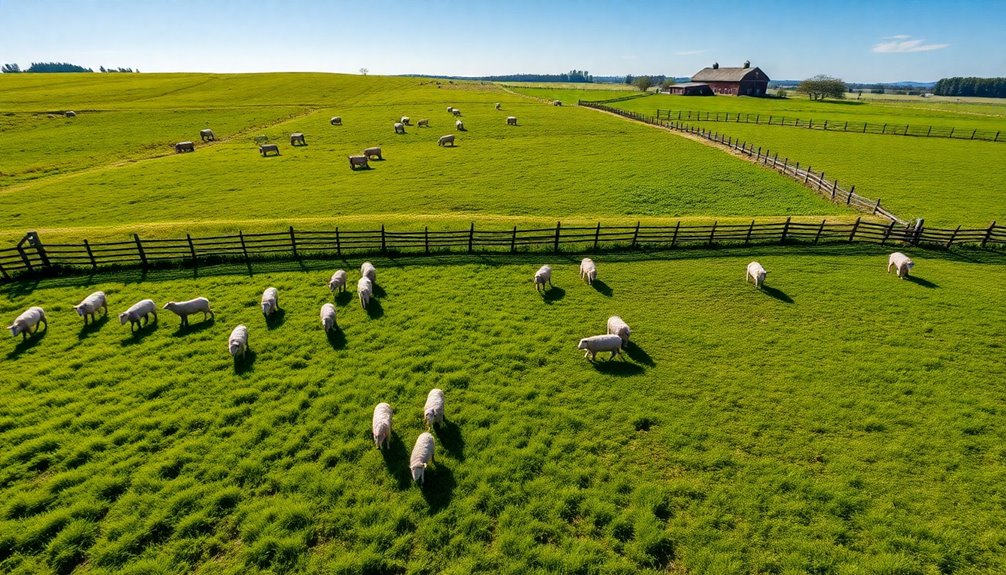
When considering sheep farming, the cost of shifting from other livestock can be a major factor.
However, various financial incentives are often available to help offset these expenses.
Understanding these economic aspects can guide you in making a profitable decision for your land.
Cost of Transitioning
Shifting to rotational grazing can be a cost-effective choice for sheep farmers looking to enhance their operations. The cost of altering primarily includes investments in fencing and water supply materials, essential for developing an effective grazing plan.
While existing fencing can reduce costs, you should consider:
- Initial investment in fencing materials
- Costs for water supply improvements
- Time for planning a rotationally grazed system
- Potential need for pasture renovation
- Long-term savings through improved land health
Despite potentially lower yields compared to confinement operations, rotational grazing can lead to greater net farm income per ewe.
Financial Incentives Available
Exploring financial incentives can greatly enhance the feasibility of adopting rotational grazing practices. Programs like the Farm Bill's EQIP and CSP offer monetary and technical support for farmers shifting to these sustainable methods.
To qualify, you'll need a certified grazing plan, which promotes best practices that improve pasture productivity and soil health. Notably, rotational grazing can lead to higher net farm income per cow than confinement methods, making it a financially viable choice.
Although initial costs for fencing and water supply can be considerable, they're often offset by lower maintenance expenses and increased livestock productivity.
With effective pasture management, you could support 8-10 ewes and their lambs per acre, considerably boosting your profitability. Additionally, implementing secure payment processing can further increase your business credibility and customer trust, enhancing your overall financial stability.
Implementing Effective Grazing Strategies
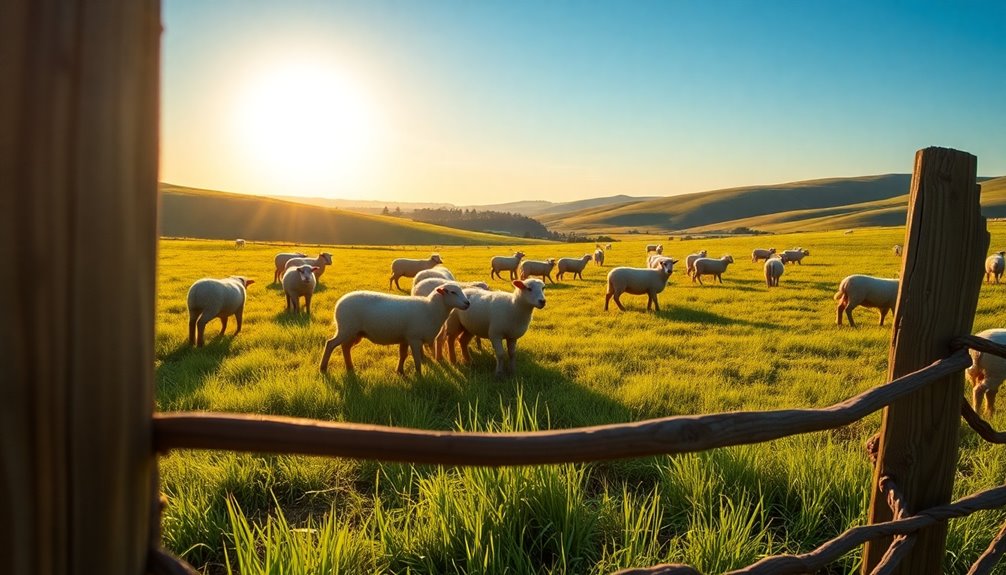
How can you maximize your pasture's potential while ensuring the health of your sheep? Effective grazing strategies are key to optimizing land use and improving pasture productivity. Here are some tips to implement:
- Maintain stocking rates of about 10 ewes and 15 lambs per acre.
- Use strip grazing with paddocks for 35-45 days to promote plant vigor.
- Regularly monitor pasture conditions to adjust grazing plans accordingly.
- Utilize a grazing calendar to schedule periods for diverse forage types.
- Incorporate legumes like clovers to boost nitrogen levels and overall quality.
Frequently Asked Questions
How Many Sheep per Acre for Grazing?
When considering how many sheep you can graze per acre, it's crucial to assess your pasture's productivity.
Generally, you might stock around 2 sheep per acre for non-rotational grazing.
However, if you're using rotational grazing, you could manage 10 ewes and 15 lambs per acre.
Improved pastures can support even more, with 8-10 ewes and their lambs per acre being ideal.
Always adjust based on your land's conditions for best results.
How Many Sheep Does It Take to Clear an Acre?
To clear an acre effectively, you'll need to contemplate the sheep's grazing habits, the pasture's condition, and the desired outcome.
Generally, you'll find that 10 ewes and their lambs can manage an acre under rotational grazing. However, if you're using non-rotational methods, expect to use about 2 sheep per acre.
How Many Sheep to Make a Profit?
To make a profit with sheep, you need to carefully consider your stocking rate and pasture management.
Aim for about 8 to 10 ewes and their lambs per acre to optimize utilization. You'll see better returns since sheep convert forage into marketable products more efficiently than cattle.
Do Sheep Ruin Grazing Land for Cattle?
Did you know sheep can utilize 26% more forage than cattle? They won't ruin grazing land for cattle if managed properly.
In fact, their grazing habits can actually improve pasture health by controlling weeds and enhancing soil fertility.
However, you need to monitor stocking rates carefully. Overgrazing can occur if sheep and cattle share the same land without adequate recovery time, so keep an eye on your grazing practices for best results.
Conclusion
So, you thought cramming as many sheep as possible onto your land would maximize yield? Ironically, overstocking can lead to poor pasture health and lower productivity. By understanding stocking rates, rotational grazing, and effective forage management, you'll find that less really can be more. Prioritizing your sheep's dietary needs and the land's capacity guarantees a thriving farm. Embrace the irony: giving your pasture room to breathe might just lead to the ultimate sheep success story.

